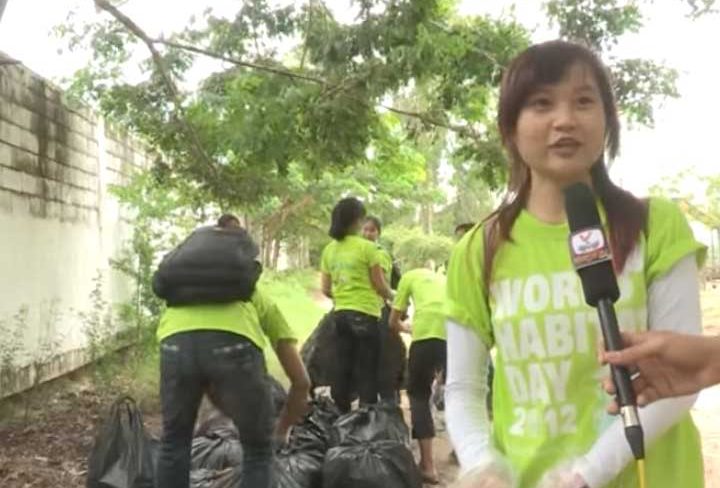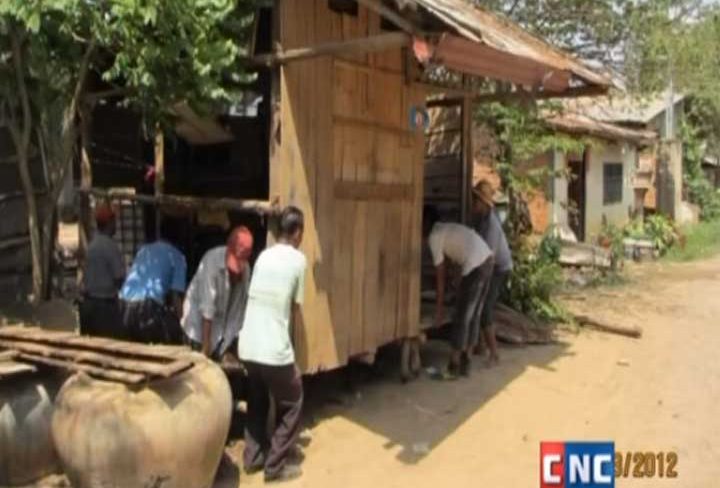
What They Say
 Nov Saroeun knows exactly what will happen on her first night in her new Habitat for Humanity house. “I will be too excited to sleep,” said the 31-year-old mother of two. “I am so happy!”
Nov Saroeun knows exactly what will happen on her first night in her new Habitat for Humanity house. “I will be too excited to sleep,” said the 31-year-old mother of two. “I am so happy!”
Saroeun is among 22 families who built their new houses together with more than 300 international volunteers during the Khmer Harvest Build from 15th to 19th November. The new houses are located in Oudong, Kandal
province, about an hour’s ride from the capital Phnom Penh. Habitat for Humanity has already built 28 houses on the 800 square meters plot of land.
The volunteers came from New Zealand, United States, Germany, Australia, Hong Kong, China, South Korea, South Africa, Canada, Mexico, United Kingdom, Singapore and Malaysia. Saroeun kept busy throughout the weeklong build, assisting the American and China-based volunteers with various tasks. By the fifth and
final day of the build, she was tidying up her house for dedication.
Saroeun and her family used to live near a local dumpsite in Phnom Penh where her husband Chin Vor, 42, works as a scavenger. Her new 24 sq. m. row house unit is a far cry from her old stilt house made of scrap metal and wood. Like the other 21 houses, Saroeun’s house is made of soil blocks with corrugated metallic roofing.
The house comes with an adjoining kitchen area and attached toilet. A gutter along the side of the roof collects rainwater which will run into a cement tank outside the house. Solar panels on the roof will enable Saroeun’s family to power a fan, an overhead light and a radio. Saroeun was a garment factory worker in Phnom Penh. After moving to Oudong, she wants to set up a home-based grocery business selling dry goods such as garlic, snacks and sweets. Her husband wants to find work in construction because of his previous background.
 Her children’s education is important to Saroeun. “My children will go to school in Oudong. I love my house very much because it is my own house on my own land. The children will have a good future here.”
Her children’s education is important to Saroeun. “My children will go to school in Oudong. I love my house very much because it is my own house on my own land. The children will have a good future here.”
Saroeun’s joy is shared by Habitat volunteers. Amy Fordham, a book-keeper from Colorado, U.S., who was on her maiden build with Habitat, said: “After handing over the house, I feel very fulfilled by being a part of the house.”
Most of the international volunteers not only built houses but also made soil blocks and worked on a nearby farm, a partnership between Habitat for Humanity Cambodia and International Children’s Care Australia.
The soil blocks used in the Khmer Harvest Build are more environmentally friendly because they are not fired in the kiln. Each day, the volunteers made the blocks at a covered area near to the build site. A mix of the local
red soil, sand, cement and water is poured into the moulds which can each produce eight soil blocks. The blocks are left to dry and are ready for use in four weeks.
Block-making was hard work, especially when the temperature averaged 33 degrees Celsius (91 degrees Fahrenheit). “Blockmaking is physical and you don’t have to think too much about it. I like it,” said John Smet who could get straight down to work on the first day of the build when most volunteers were settling down to house construction. John sits on the board of HFH Greater Los Angeles, a Habitat affiliate in the U.S. He and his wife signed up for Khmer Harvest Build because they enjoyed their volunteer stint during the 2009 Jimmy & Rosalynn Carter Work Project which took place in five Mekong Delta countries.
 Over at the two-hectare farm, about a 10-minute drive away, volunteers tried their hand at traditional ploughing using a bullock. They also planted vegetables seeds, built trellises for beans, laid blocks to build a poultry shed and fished with a net. For many volunteers like South Korea’s Yoo Sun Chon, the highlight of the day was a ride in a bullock cart. The 24-year-old fresh university graduate, a first-time volunteer, said of the Khmer Harvest Build: “It is not just the experience of building a house but there are also the farm and block-making, meeting people and making friends.”
Over at the two-hectare farm, about a 10-minute drive away, volunteers tried their hand at traditional ploughing using a bullock. They also planted vegetables seeds, built trellises for beans, laid blocks to build a poultry shed and fished with a net. For many volunteers like South Korea’s Yoo Sun Chon, the highlight of the day was a ride in a bullock cart. The 24-year-old fresh university graduate, a first-time volunteer, said of the Khmer Harvest Build: “It is not just the experience of building a house but there are also the farm and block-making, meeting people and making friends.”
Another group of volunteers also did landscaping works at the community center which was completed by Global Village volunteers from United States just before the build begun. They did the paving around the
community center, livened up the place with potted plants and covered inside of the roof with bamboo strips.
On the last day of the build, volunteers hung up country flags and balloons, adding color to the houses. Hugs were exchanged and group photographs were snapped as families and volunteers alike shed tears of joy. Cambodian volunteer translator Luch Pich admitted that he was so moved that his voice broke when he was translating the dedication message by the international volunteers.
Shortly after lunch, hundreds of Habitat volunteers, staff and skilled workers presented a graphic statement to mark World Toilet Day. For one minute, all went down and formed the word “Squat” to highlight the dire need
for adequate and safe sanitation facilities for over two billion people in the world.
The Khmer Harvest Build ended on a high note with volunteers presenting items including line-dancing and a Maori war cry. A traditional Cambodian dance had volunteers springing up from their seats to join in. As dusk fell, all was quiet again. The 22 families will begin a new chapter in their lives. Nov Saroeun is upbeat. “I want life to get better and better.”




